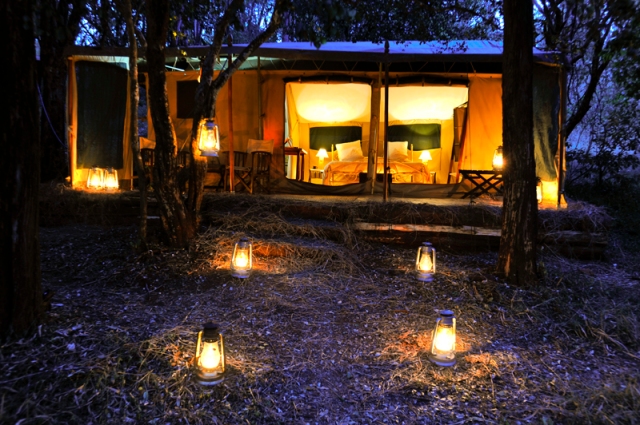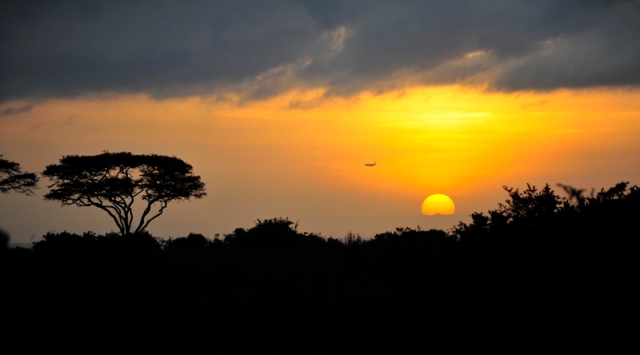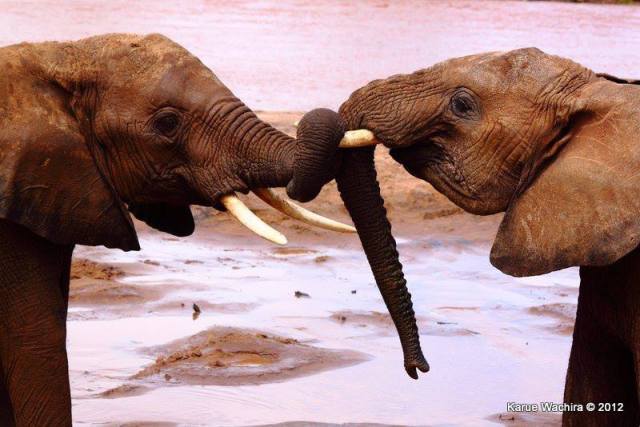Ever felt like a “Kid in a candy store”?

Drinks and refreshments awaiting you…
Well, that’s how excited I was, on my trip to the Nairobi Tented Camp.
Armed with my camera, notebook and definitely the wrong shoes 😛 , I walked into the Nairobi National Park, along Lang’ata Road in Nairobi, home to the Nairobi Tented Camp. And What originality, What tranquility i found – a slice of heaven set to offer you an unforgettable safari adventure right in the heart of the Central Business District.
Fondly referred to as the NTC, the Nairobi tented Camp is a traditional tented camp that began 5 years ago through an initiative between Mr. Guy Lawrence, Mr. Will Knocker and the Kenya Wildlife Service. Surrounded by vast savannah and thick forest, Nairobi Tented Camp is an eco-tourist centre of strong conservation beliefs and is renown as the only tented camp accommodation inside the Nairobi National Park!

Undisturbed, untainted…. the Nairobi Tented Camp.
Unveiling the Nairobi Tented Camp:

Karibu NTC!
The tented camp is managed by the GameWatchers Safaris Group, headed by Jake Grieves- Cook, and have promised to offer you an authentic safari experience in Nairobi, Kenya with low impact to the natural environment, and without compromising on the quantity of fun you’ll have!
Nairobi tented Camp has 5 star ratings on eco-friendliness, cleanliness,service and staff at NTC, with excellent reviews throughout the world; It is ranked as the #2 Bed and Breakfast Inn in all Nairobi at TripAdvisor.com and received their Traveller’s Choice 2013 Winner Award.
I had heard greatly of the eco-friendliness and unique blend that the NTC has with the natural environment within the Nairobi National Camp. So I set out to visit the world-renowned gem in the heart of Nairobi that we Kenyans, might not be aware of 😦

The vast Nairobi National Park is home to diverse wildlife species …
I met Ms. Aleema and Ms. Chantal, both representatives from the GameWatchers Safaris and Meshack, a third generation Maasai tour guide for our trip. To say I was excited is an understatement: I paid Ksh. 300.00 as entry fee for East African citizens into the park.
NB: You might need a 4X4 vehicle coming to the Nairobi Tented Camp, as no trees have been cut to pave way hence you need to meander in the wild, uneven paths although a route has been set so that you don’t get lost.

Voom! Voooooom ! NTC, here we come 🙂
CAUTION : You need to be ready with a good video/ camera for all the amazing wildlife you are bound to see 🙂

Kurelax nayo…
After a 30 minute ride of great conversation and sight-seeing,we got to the Nairobi Tented Camp…

TURN LEFT: Almost there….
The Visitor’s Lounge…

Looks like home, feels like home.
After a welcoming drink of choice, we took a stroll around the NTC camp. I found out there are 8 tents, strategically placed within the camp, for a maximum of two people per tent per night. The camp’s signature brown canvas tent are designed to give you that out-in-the-wild, camping feel in the heart of the Capital.
Nairobi Tented Camp is equipped with hot water showers and powered with electricity from the Solar power panels. Wildlife comes to your doorstep, literally,as curious monkeys come for a drink of water in the nearby river that is located a few meters from the camp lounge.
We also saw a female bush-back observing us keenly (There is an opportunity for close interaction with the wildlife), docile buffaloes basking in the sun, hippos mating in the lukewarm water under the afternoon weather, not forgetting the giraffes,lions, and rhinos you’ll get to see at the neighbouring active water points and an amazing array of indigenous trees and greenery to boot.

Excellent service.
Lots of Wildlife near the camp:

Good Monkey, don’t jump on my head 🙂

A look at the tented camps interior… What modern amenities they have!

Entrance to your tented camp.. A sight to behold.

My Luggage is set, I’m ready to have my Safari Experience …

Aaaahhh… what comfort!
The Nairobi Tented Camp is proud to upholds its strict eco-policy that governs Responsible tourism practices within the camp. Through their environmental management programme,NTC protects the animals’ natural habitat at the park through the following steps :
- The camp is fully mobile…yes, you read right! Nairobi Tented Camp is a semi-permanent camp made of canvas tents that has minimal disturbance to the environment. Except for the tent pegs holding the canvas camping tent up, there are no other disturbances to the ground.
- No tree was cut in the setting up of the Nairobi Tented Camp. All the wood used has been bought from commercial farmers. No tree has been fell, from the rugged road leading to the camp to the camp area itself (No deforestation! )
- The camp is self-sufficient: Its electricity needs are tendered to by Solar Power (Renewable energy) . They recently upgraded their solar power panels, how green!
- All waste water (from the accommodation tents, mess areas and kitchen ) in the camp is collected into a central septic tank, treated and disposed off site. This prevents chance of sewage seeping into the environment.
- Solid waste such as paper and garbage are collected and disposed off outside the National Park by the GameWatchers Safaris Team to avoid pollution at the natural reserve. Cleaning and Ironing of ALL laundry is also undertaken outside the park.
- Bathing water is heated for you and put in 20 litre canvas bucket showers to minimise water wastage in the camp.
- Nairobi Tented Camp discourages bringing of bottled water into the camp to prevent accumulation of the plastic bottles at the camp. The camp provides you with fresh spring water hence no need for plastic bottles. NB: These plastic papers and bottles pose an inherent danger to the wildlife if left littering the wild, as they can be ingested by the animals thus causing digestive disorders and even suffocation to the animals.. do take care.
For those who enjoy birding, Nairobi Tented Camp is ideal for you: with various species of birds in the park, NTC is home to, among many other species, the Turaco bird, which is a symbol of Royalty in some parts of Africa. For insect lovers out there, we managed to come across the Spiny orb weaver spider, of the Gasteracantha genus.
Can you spot it?

Spiny orb weaver , Nairobi Tented Camp, Kenya.
DID YOU KNOW?
GameWatchers Safaris currently have an ongoing offer for residents at only Ksh. 8,500 /= per person on Half Board Basis (Dinner, Bed and Breakfast)! That means a night in the heart of the wild untamed Nairobi National Park, inclusive of excellent food and bush dinners from Chef Silas, sun downers, walks in the pack, and a picnic and/or a night game drive can be arranged for you by NTC’ s manager, Mr. Hubert.
So the next time you are in Nairobi, or are in search of a weekend outing plan, stop by the Nairobi Tented Camp and experience luxury and comfort,the Kenyan style.
PS: When you get there, do say hi to the resident Rhino and her calf, namely Joanne and baby J respectively 🙂
Keep it locked on the Leafy Agenda!

Sun downers at Nairobi Tented Camp: Paradise *
(Photos, Courtesy of GameWatchers Safaris.)



 I am honored to be nominated for the Liebster award which is for up-and-coming blogs.Here are my answers to the interview questions given by my nominator, Beatrice Onyango who blogs at
I am honored to be nominated for the Liebster award which is for up-and-coming blogs.Here are my answers to the interview questions given by my nominator, Beatrice Onyango who blogs at























